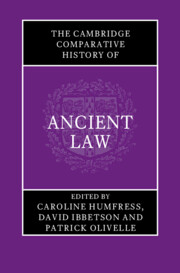Book contents
- The Cambridge Comparative History of Ancient Law
- The Cambridge Comparative History of Ancient Law
- Copyright page
- Contents
- Figures
- Maps
- Contributors
- Preface
- Additional material
- Additional material
- Abbreviations
- Maps
- 1 Orientation
- 2 Law as Text
- 3 Legal Science
- 4 War, Peace and Interstate Relations
- 5 Law and the State
- 6 Law and Religion
- 7 Legal Procedure
- 8 Status and Family
- 9 Crime, Redress and Social Control
- 10 Property
- 11 Commerce and Contracts
- 12 Conclusion
- Bibliography
- Index
11 - Commerce and Contracts
Published online by Cambridge University Press: 09 May 2024
- The Cambridge Comparative History of Ancient Law
- The Cambridge Comparative History of Ancient Law
- Copyright page
- Contents
- Figures
- Maps
- Contributors
- Preface
- Additional material
- Additional material
- Abbreviations
- Maps
- 1 Orientation
- 2 Law as Text
- 3 Legal Science
- 4 War, Peace and Interstate Relations
- 5 Law and the State
- 6 Law and Religion
- 7 Legal Procedure
- 8 Status and Family
- 9 Crime, Redress and Social Control
- 10 Property
- 11 Commerce and Contracts
- 12 Conclusion
- Bibliography
- Index
Summary
Chapter 11 focuses on ancient ‘contracts’, with specific reference to commerce, property and other economic activities for which there is relevant evidence. The chapter begins with urbanization in southern Mesopotamia in the fourth millennium bce, bringing together archaeological, material and written evidence in order to introduce a broad working idea of ‘contracts’. The next section moves on to a discussion of technical ancient terms and concepts, noting the ‘considerable terminological instability in the common English translations of the original terms’. The following section turns to ‘contracts’ between states, whilst the next develops a comparative analysis of ‘oaths in interpersonal agreements’. The following two sections analyse specific questions surrounding the use of writing and ’the contract of sale’, noting that there is surviving evidence for the use of (different forms of) contacts of sale across every ancient legal system. The chapter concludes by drawing together a set of generalized conceptions of ‘contract’ and briefly suggesting that long-distance trade - among other factors - may lie behind some of the similarities - for example the use of seals - evident across the extant ancient evidence.
Keywords
- Type
- Chapter
- Information
- The Cambridge Comparative History of Ancient Law , pp. 565 - 597Publisher: Cambridge University PressPrint publication year: 2024

